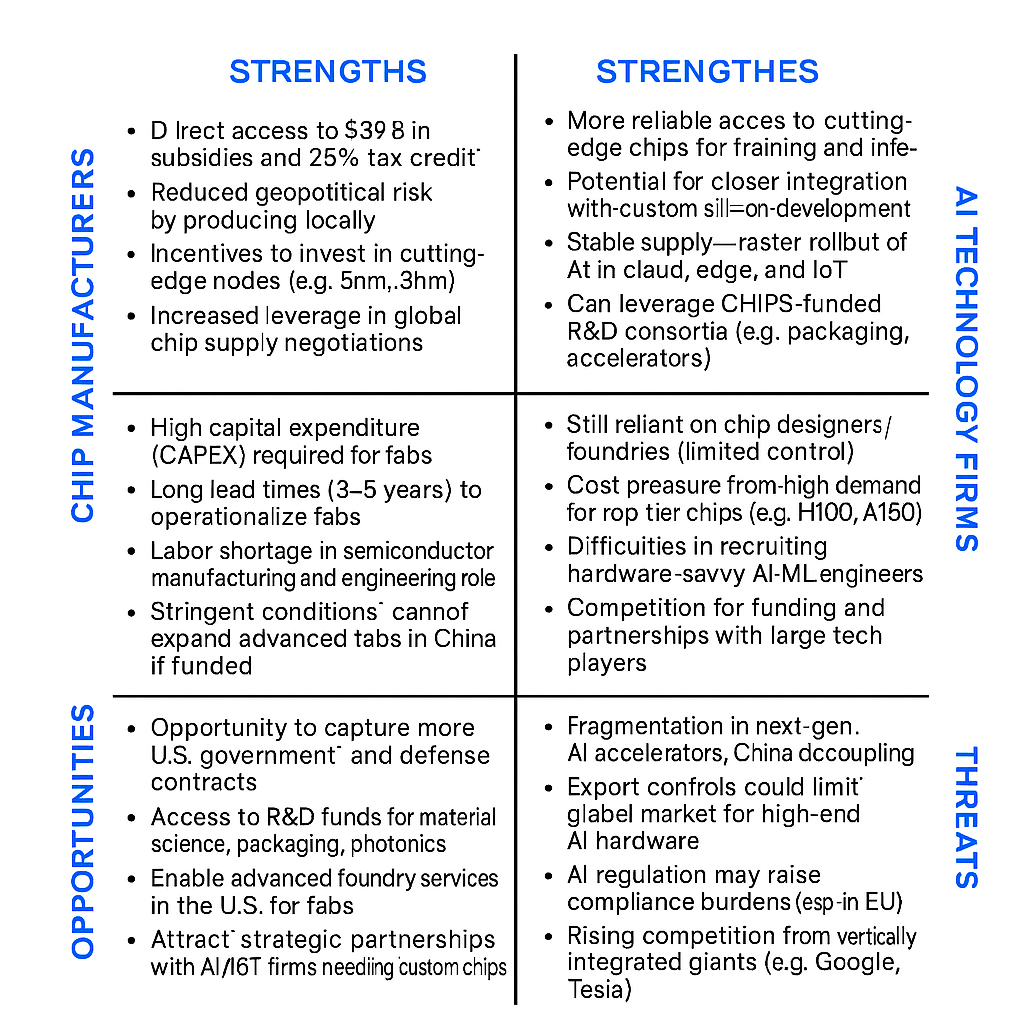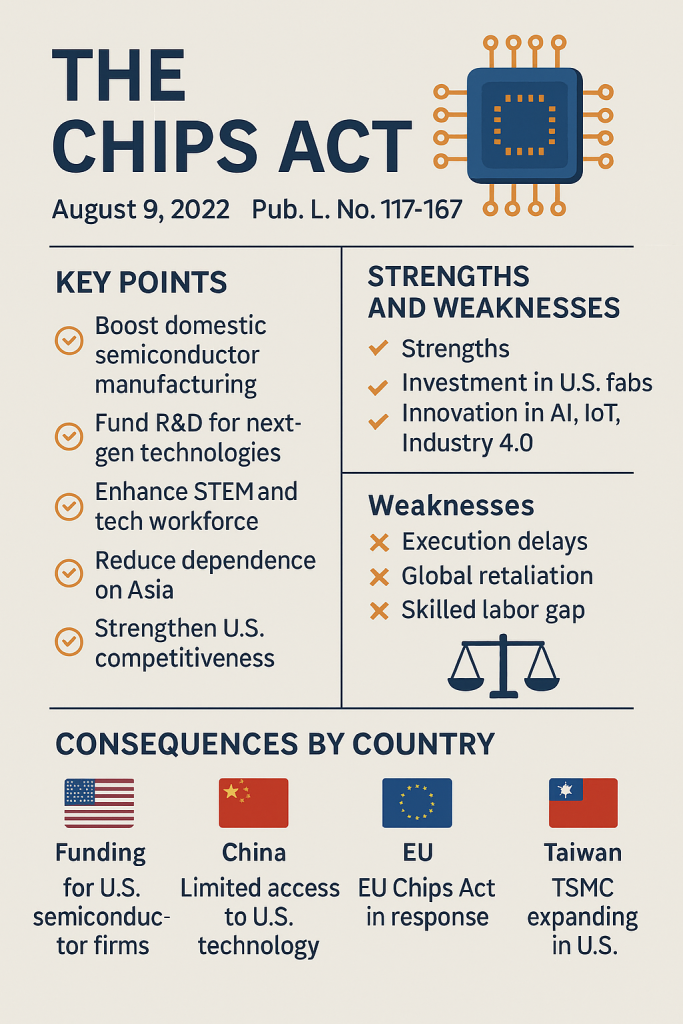The CHIPS Act (Creating Helpful Incentives to Produce Semiconductors) is a landmark U.S. federal law designed to boost domestic semiconductor manufacturing, research, and supply chain security, primarily in response to global chip shortages and rising competition from China. It is a central component of U.S. industrial policy tied to national security, technological leadership, and the future of digital transformation—including AI, IoT, and Industry 4.0.
Key Facts
- Full name: CHIPS and Science Act
- Signed into law: August 9, 2022
- Public Law: 117-167
- Total funding: ~$280 billion (including ~$52.7 billion specifically for semiconductor-related activities)
- Administered by: U.S. Department of Commerce
Objectives of the CHIPS Act
- Reinforce U.S. chip production capacity (manufacturing subsidies & tax credits).
- Fund R&D for next-gen semiconductors and AI/quantum technologies.
- Enhance STEM and advanced tech workforce development.
- Reduce dependence on Asia-based supply chains (esp. Taiwan and China).
- Strengthen U.S. competitiveness in strategic sectors like defense, AI, IoT, 5G, Industry 4.0, etc.
Major Funding Streams
| Purpose | Budgeted Amount |
|---|---|
| Manufacturing incentives | $39 billion in subsidies |
| R&D (National Semiconductor Technology Center, etc.) | $11 billion |
| Workforce development | Part of R&D funding |
| Investment tax credit (25%) | Estimated $24 billion |
Impacts on the Market
a - Strengths / Opportunities
| Area | Effect |
|---|---|
| Chip Manufacturers (US & Allies) | Massive incentive to invest in U.S. fabs (e.g., Intel, TSMC, Samsung) |
| AI & IoT Startups | Benefit from stable chip access and R&D ecosystem |
| Industry 4.0 | Improved reliability of local chip supply = less production risk |
| Digitalization Projects | More resilience in procurement for advanced computing solutions |
| Geopolitical Leverage | Reduces tech dependence on geopolitical rivals like China |
b - Stresses / Weaknesses
| Issue | Risk/Challenge |
|---|---|
| Execution delays | Long timelines to build fabs (3–5 years typical) |
| Skilled labor gap | Shortage of qualified engineers and technicians |
| Global retaliation | EU and Asian nations launched similar subsidy programs in response |
| Inflationary costs | Construction and material costs rising rapidly |
| Capital concentration | Mid-sized firms and startups may be crowded out by mega players |
Global Responses by Country
United States
- Beneficiaries: Intel, Micron, GlobalFoundries, and new U.S. fabs from TSMC (AZ), Samsung (TX).
- Push: U.S. sovereignty in critical tech (defense, telecom, autonomous systems).
China
- Response: Doubling down on “Made in China 2025,” heavy investments via SMIC.
- Risk: U.S. export controls and CHIPS Act limit access to advanced U.S. chip technology.
European Union
- EU Chips Act (launched 2023): €43 billion in support; aims for 20% global chip share by 2030.
- Focus: Advanced nodes, automotive chips, RISC-V, sustainability.
South Korea
- Strategic Push: Samsung and SK Hynix increasing investments in R&D and U.S. fabs.
- Leverage: Maintaining competitiveness while securing access to U.S. and EU markets.
Japan
- Renewed interest in chip production with support for firms like Rapidus (with IBM).
- Goal: Regain relevance in advanced semiconductor production.
Taiwan
- TSMC building U.S. fabs, but remains critical to global supply chain (especially <5nm).
- Challenge: Geopolitical risk makes clients seek geographic diversification.
Consequences for Digitalization & Industry 4.0
- More secure chip supply → reduced delays for IoT, AI edge devices, industrial sensors.
- Higher U.S./Western production → More reliable sourcing for EU/US manufacturers.
- Increased cost pressures for firms outside U.S. incentive zones.
- Innovation acceleration in photonics, edge AI, embedded computing, quantum chips.
Summary of Key Players Impacted
| Segment | Examples | Expected Outcome |
|---|---|---|
| US chipmakers | Intel, Micron, GlobalFoundries | Major funding boosts and tax credits |
| Asian chip giants | TSMC, Samsung | Incentivized to open U.S. fabs; geopolitical balancing |
| IoT/AI firms | NVIDIA, AMD, startups | Benefit from R&D and stable chip supply |
| Industrial OEMs | Siemens, ABB, GE Digital | Improved planning, reduced chip-based delays |
| Digital integrators | SAP, Oracle, Microsoft | Can count on robust infrastructure for AI/ML/IoT tools |
Here is an industry-specific analysis for the sectors mentioned under the "Impact on the Market" section—Chip Manufacturers, AI & IoT Firms, Industry 4.0 Integrators, and Digitalization Projects—in light of the CHIPS Act:
1. Chip Manufacturers
Impact:
- U.S. firms (Intel, Micron, GlobalFoundries) receive direct subsidies and tax incentives to expand domestic production.
- Foreign leaders (TSMC, Samsung) investing in U.S.-based fabs become eligible for funding—but must restrict expansion in China.
Strategic Shifts:
- Reshoring of critical manufacturing.
- Diversification of production beyond Taiwan and South Korea (geo-risk mitigation).
- Focus on sub-5nm node development within U.S. territory.
Risks:
- High CAPEX requirements and lengthy ramp-up times (3–5 years).
- Labor shortages for specialized fab roles (engineers, technicians).
2. AI and IoT Firms
Impact:
- Greater access to U.S.-produced chips—critical for smart devices, edge computing, and AI inference.
- Boost in AI accelerator chip availability (e.g., for NLP, CV, etc.).
Opportunities:
- Reduced supply chain volatility, enabling faster product iteration.
- Support for custom silicon development and edge AI chips via R&D funding.
- Closer partnerships with fabless chip designers benefiting from the Act (e.g., AMD, NVIDIA, Qualcomm).
Challenges:
- Costs may still remain high until U.S. fabs reach scale.
- Talent war intensifies, particularly for hardware-aware AI developers and embedded system engineers.
3. Industry 4.0 (Smart Manufacturing, Automation)
Impact:
- More stable chip supply for robotics, sensor systems, PLCs, and autonomous industrial equipment.
- Encourages regionalized production ecosystems aligned with national industrial policy.
Benefits:
- Less risk of disruption in critical machine control systems due to chip shortages.
- Easier integration of real-time analytics and digital twins via edge computing.
Strategic Trends:
- U.S. and allied nations may become more attractive for greenfield Industry 4.0 investment.
- Embedded AI systems in machinery become more viable and cost-predictable.
4. Digitalization Projects (ERP, MES, IIoT Platforms)
Impact:
- Digital transformation programs are less likely to be stalled due to hardware delays.
- Cloud and hybrid infrastructure vendors (AWS, Azure, Google Cloud) benefit from long-term chip access and partnerships.
Implications:
- Predictable hardware delivery timelines improve ROI modeling and execution schedules.
- Data processing power at the edge (via AI-enabled chips) allows for more autonomous systems with lower latency.
Summary Table
| Sector | Positive Outcomes | Key Risk |
|---|---|---|
| Chip Manufacturers | Large-scale U.S. investment, market share protection | Long ramp-up, talent shortage |
| AI & IoT Firms | Stable access to advanced semiconductors | Cost and competition for chip supply |
| Industry 4.0 | Reliable sourcing for automation & control | Dependence on U.S. policy shifts |
| Digital Projects | Hardware-backed resilience for digital rollouts | Potential chip overspecification/cost |
Here is a strategic SWOT analysis for both Chip Manufacturers and AI Technology Firms based on the CHIPS Act's implications:
1. Chip Manufacturers – SWOT Analysis
| Strengths | Weaknesses |
|---|---|
| Direct access to $39B in subsidies and 25% tax credit. | High capital expenditure (CAPEX) required for fabs. |
| Reduced geopolitical risk by producing locally. | Long lead times (3–5 years) to operationalize fabs. |
| Incentives to invest in cutting-edge nodes (e.g., 5nm, 3nm). | Labor shortage in semiconductor manufacturing and engineering roles. |
| Increased leverage in global chip supply negotiations. | Stringent conditions: cannot expand advanced fabs in China if funded. |
| Opportunities | Threats |
|---|---|
| Opportunity to capture more U.S. government and defense contracts. | Retaliatory subsidies from China, EU, and South Korea (subsidy race). |
| Access to R&D funds for material science, packaging, photonics. | Overcapacity risk if global demand slows post-2025. |
| Enable advanced foundry services in the U.S. for fabless firms. | Inflation and raw material volatility. |
| Attract strategic partnerships with AI/IoT firms needing custom chips. | Risk of tech leaks, IP theft in joint ventures. |
2. AI Technology Firms – SWOT Analysis
| Strengths | Weaknesses |
|---|---|
| More reliable access to cutting-edge chips for training and inference. | Still reliant on chip designers/foundries (limited control). |
| Potential for closer integration with custom silicon development. | Cost pressure from high demand for top-tier chips (e.g., H100, A100). |
| Stable supply = faster rollout of AI in cloud, edge, and IoT. | Difficulties in recruiting hardware-savvy AI/ML engineers. |
| Can leverage CHIPS-funded R&D consortia (e.g., packaging, accelerators). | Competition for funding and partnerships with large tech players. |
| Opportunities | Threats |
|---|---|
| Collaborate on next-gen AI accelerators, neuromorphic chips. | Fragmentation in global chip availability (China decoupling). |
| Expand into hardware-software co-design for AI edge devices. | Export controls could limit global market for high-end AI hardware. |
| Tap into federal R&D infrastructure (e.g., NSTC). | AI regulation may raise compliance burdens (esp. in EU). |
| Integrate AI in more industrial and government use cases. | Rising competition from vertically integrated giants (e.g., Google, Tesla). |
Strategic Impact of the CHIPS Act on Semiconductor Manufacturing and AI Technology: A Dual-Sector SWOT Analysis

Below is a link to the US department of commerce feedback on the CHIPS Law




